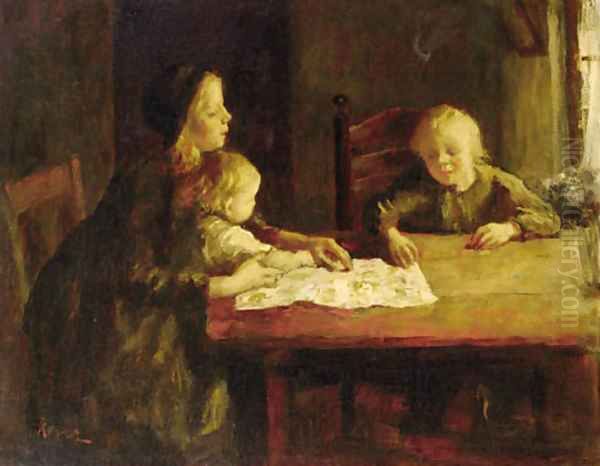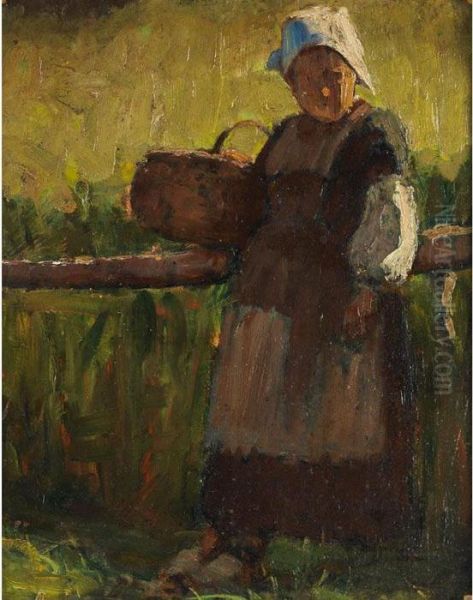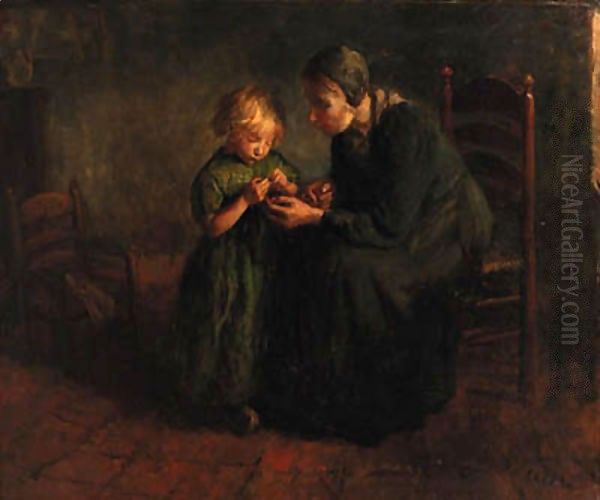Jacob Simon Hendrik Kever stands as a significant figure in Dutch art during the late 19th and early 20th centuries. Born in Amsterdam on June 19, 1854, and passing away in Laren on April 29, 1922, Kever dedicated his artistic career primarily to capturing the quiet intimacy and simple dignity of Dutch domestic life, particularly within rural settings. His nationality was Dutch, and his entire life and artistic output were deeply rooted in the cultural and social landscape of the Netherlands. He became closely associated with the Laren School, an artists' colony that flourished in the Gooi region, known for its focus on peasant life and the surrounding landscapes. Kever's work, characterized by its sensitivity, harmonious color palettes, and focus on interior scenes, offers a valuable window into the everyday world of ordinary Dutch people of his time.
Early Life and Artistic Formation
Jacob Kever was born into a prosperous family in Amsterdam. This comfortable background provided him with opportunities that might not have been available to others. His mother, while not married to a member of the Israëls family as sometimes mistakenly suggested, was acquainted with the circle of the renowned painter Jozef Israëls, a leading figure of the Hague School. This connection proved beneficial, as it helped the young Jacob gain access to established artists' studios for his initial training.
His formal artistic education began under the tutelage of the prominent Amsterdam painter and lithographer Petrus Franciscus Greive. Greive's studio was a respected training ground, and studying there provided Kever with a solid foundation in drawing and painting techniques. This early exposure shaped his understanding of composition and form, skills that would become hallmarks of his later work.

Seeking broader experience, Kever traveled to Antwerp, Belgium, in 1878. There, he enrolled at the prestigious Royal Academy of Fine Arts. His instructor was Charles Verlat, a Belgian painter known for his historical scenes, animal paintings, and portraits. Studying in Antwerp exposed Kever to different artistic currents and techniques prevalent outside the Netherlands. During his time at the Academy, he studied alongside fellow Dutch artist Theo Hanraads, sharing experiences and likely engaging in artistic dialogue that furthered his development.
The Hague School Context and Developing Focus
Kever's formative years coincided with the flourishing of the Hague School (Haagse School), the dominant movement in Dutch painting during the latter half of the 19th century. This school emphasized realism, atmospheric effects, and often depicted Dutch landscapes, coastal scenes, and the lives of fishermen and farmers. Key figures like Jozef Israëls, Anton Mauve, the Maris brothers (Jacob, Willem, and Matthijs), Hendrik Willem Mesdag, and Willem Roelofs set the tone with their often somber palettes and focus on capturing the mood and light of the Dutch environment.
While Kever absorbed the influence of the Hague School's commitment to realism and its interest in everyday subjects, his own artistic temperament led him increasingly towards interior genre scenes rather than the expansive landscapes favored by many of his contemporaries. He was drawn to the enclosed, intimate spaces of homes, particularly those of the rural working class. This focus allowed him to explore nuances of light, texture, and human presence within a contained setting.
His decision to specialize in interiors might also have been influenced by practical considerations. Working independently in Eemnes, a village in the Gooi region near Laren and Blaricum, Kever reportedly chose subjects that did not require expensive models, finding ample inspiration within the homes and daily routines of the local villagers. This practical necessity dovetailed perfectly with his growing artistic interest in domestic themes.
Settling in the Gooi: The Move to Laren
The Gooi region, southeast of Amsterdam, encompassing villages like Laren, Blaricum, and Eemnes, became a magnet for artists towards the end of the 19th century. Attracted by the picturesque landscape, the perceived authenticity of rural life, and the relatively low cost of living compared to the cities, artists began to settle there, forming what became known as the Laren School. Anton Mauve, a cousin-in-law of Vincent van Gogh and a leading Hague School painter, was one of the first prominent artists to move to Laren, significantly boosting its appeal.

Jacob Kever was among the artists drawn to this burgeoning colony. He spent considerable time working in Eemnes before eventually settling more permanently in Laren. In 1887, he acquired a house in Laren, solidifying his connection to the area that would provide the primary inspiration for the rest of his career. His home was situated near "Ariëtte" (sometimes mistakenly referred to as "Vrippy"), the villa belonging to Anton Mauve. Living in close proximity to Mauve undoubtedly fostered artistic exchange and influence, although Kever maintained his distinct focus on interior scenes while Mauve was renowned for his landscapes with sheep.
Life in Laren provided Kever with direct access to the subjects that fascinated him: the modest farmhouses, the villagers, and their daily activities. He became a keen observer of the local way of life, translating his observations into paintings that conveyed both the hardships and the quiet dignity of his subjects.
The Laren School and Artistic Community
Kever became an integral part of the Laren School, a loose association of artists rather than a formal institution with a strict manifesto. The common thread was their shared interest in depicting the local environment and its inhabitants. Alongside Kever, prominent figures associated with the Laren School included Anton Mauve, Albert Neuhuys, Evert Pieters, Wally Moes, Arina Hugenholtz, and Kever's own brother, Hein Kever, who was also a painter.
Albert Neuhuys, in particular, shared Kever's focus on peasant interiors, often depicting mothers and children in sunlit rooms. While their subject matter was similar, critics often noted differences in their approach. Kever's work was frequently described as having a quieter, perhaps more introspective or melancholic mood compared to the often brighter, more anecdotal scenes by Neuhuys. Kever's compositions emphasized harmony and subtle tonal relationships.
The Laren artists often socialized and shared ideas, creating a supportive environment. They drew inspiration from the readily available subject matter – the heathlands, the sheepfolds, the weavers' cottages, and the interiors of farmhouses. Kever fully immersed himself in this milieu, finding endless variations on his chosen themes within the community around him. His commitment to depicting the local life contributed significantly to the character and reputation of the Laren School.
Kever's Signature Style: Interiors and Figures
The heart of Jacob Kever's artistic output lies in his sensitive portrayal of Dutch domestic interiors. He excelled at capturing the atmosphere of humble homes, often focusing on solitary figures or small family groups engaged in quiet, everyday tasks. His subjects were typically women and children: a mother tending to her baby, a woman knitting or sewing by a window, children playing quietly on the floor, or an elderly person reading or simply resting.

These scenes are rarely dramatic or overtly narrative. Instead, Kever focused on evoking a mood – often one of tranquility, concentration, or gentle melancholy. He paid close attention to the details of the interiors: the texture of plastered walls, the worn wooden furniture, simple pottery, and textiles. These elements were rendered with care, contributing to the overall sense of realism and authenticity.
His figures are depicted with empathy and respect. They are not romanticized, but presented with a quiet dignity. Their postures and expressions often suggest absorption in their tasks or thoughts, creating a sense of intimacy and inviting the viewer into their private world. Kever's ability to convey the emotional resonance of these simple scenes is a key aspect of his enduring appeal.
Light, Color, and Atmosphere
Light plays a crucial role in Kever's interiors. Typically, the light source is a window, often placed to the side of the composition. He masterfully rendered the way natural light falls across figures and objects, illuminating textures and creating subtle contrasts between light and shadow. Unlike some contemporaries who might have used dramatic chiaroscuro, Kever generally preferred a more diffused, gentle light that unified the scene and contributed to its peaceful atmosphere.
His color palette was often characterized by harmonious, muted tones. He favored earthy colors, soft grays, whites, and blues, reflecting the simple materials and subdued light of the interiors he depicted. While his early work might be seen as more restrained in its use of contrast and color, sources suggest that as he matured, Kever gained confidence and his brushwork became freer. His later works sometimes show a bolder application of paint and slightly stronger color accents, though always within the bounds of his characteristic tonal harmony.
The overall atmosphere in Kever's paintings is one of stillness and contemplation. He avoided sentimentality, instead achieving emotional depth through careful observation and subtle rendering. His works invite quiet reflection, offering a glimpse into a way of life that was already beginning to change during his lifetime.
Representative Works
While specific titles like "Mother's Offspring" mentioned in preliminary notes are difficult to verify or date accurately (and the connection to Gorky's novel seems erroneous), Kever's body of work is consistent in its themes. Many of his paintings are known by descriptive titles reflecting their subject matter.
Works commonly associated with Kever include numerous Boereninterieurs (Farmer's Interiors). These often feature scenes like Woman Knitting by a Window, Mother and Child near a Cradle, The Little Knitter, or Woman Peeling Potatoes. A painting titled Boerenechtpaar aan de maaltijd (Farmer Couple at Mealtime), likely similar to the "Peasant and his wife at the table" mentioned, represents a typical subject, capturing a moment of shared daily routine.
In these works, one typically finds a carefully structured composition, often with a figure positioned near a window that provides the primary illumination. The focus is on the interplay of light and shadow, the textures of simple objects, and the quiet concentration of the figure(s). For example, in scenes of women knitting or sewing, Kever captures the focused posture, the delicate movement of hands, and the textures of yarn or fabric, all bathed in soft interior light. These recurring themes, executed with subtle variations, form the core of his artistic identity.
Wider Recognition and Exhibitions
Jacob Kever achieved considerable recognition during his lifetime, both within the Netherlands and internationally. He was an active participant in the Dutch art world, exhibiting his work regularly in Amsterdam, The Hague, and other cities. He was associated with prominent artists' societies such as Arti et Amicitiae in Amsterdam and the Pulchri Studio in The Hague, which provided venues for exhibition and interaction with fellow artists.
His reputation extended beyond Dutch borders. As noted, his paintings were exhibited in major European art centers, including Brussels, Paris, and Munich. This international exposure indicates that his intimate portrayals of Dutch life resonated with audiences elsewhere in Europe, who appreciated his technical skill and the universal human qualities conveyed in his work.
His paintings were acquired by both private collectors and public institutions, ensuring their preservation and continued visibility. Today, his works can be found in the collections of major Dutch museums, including the Rijksmuseum Amsterdam, the Kunstmuseum Den Haag, and others, as well as in collections abroad. This enduring presence in museum collections attests to his established place in the history of Dutch art.
Contextualizing Kever: Comparisons and Contemporaries
Placing Kever within the broader context of late 19th and early 20th-century Dutch art helps to appreciate his specific contribution. As mentioned, his work is often compared to that of his Laren colleague Albert Neuhuys due to their shared focus on peasant interiors. While Neuhuys's scenes are sometimes perceived as brighter and more anecdotal, Kever's are often noted for their deeper quietude and more subtle emotional tone.
His work relates to the legacy of the Hague School, particularly Jozef Israëls, who also depicted the lives of humble folk, albeit often with a greater emphasis on pathos and darker tonalities. Kever adopted the realist ethos but channeled it into more serene, less overtly sentimental domestic scenes. Compared to Anton Mauve, his Laren neighbor known for atmospheric landscapes, Kever carved out his niche by concentrating almost exclusively on the interior world.
Beyond the Hague and Laren Schools, other currents were emerging in Dutch art. The Amsterdam Impressionism, represented by artists like George Hendrik Breitner and Isaac Israëls (Jozef's son), focused on capturing the dynamic, modern life of the city with bolder brushwork and a brighter palette. In contrast, Kever remained committed to his quieter, rural subjects. Symbolist artists like Jan Toorop explored entirely different realms of imagination and spirituality. Kever's steadfast dedication to his chosen genre provides a valuable counterpoint to these other movements, highlighting the diversity of Dutch art at the turn of the century.
Later Life and Legacy
Jacob Simon Hendrik Kever continued to live and work in Laren until his death in 1922 at the age of 67. He remained dedicated to his themes of domestic interiors and rural life throughout his career, refining his style and producing a substantial body of work. His paintings consistently found appreciation among collectors who valued their technical quality, peaceful atmosphere, and sensitive portrayal of Dutch heritage.
Kever's legacy lies in his contribution to the Laren School and, more broadly, to Dutch genre painting. He captured a specific aspect of Dutch culture – the intimate, everyday life within rural homes – with remarkable consistency and sensitivity. His work avoids grand narratives and focuses instead on the small, quiet moments that define human experience. He documented a way of life that was increasingly disappearing, preserving it with artistic skill and quiet empathy.
His paintings continue to be admired for their technical proficiency, particularly his handling of light and texture, and for their ability to evoke a sense of peace and timelessness. He remains a respected figure among the Dutch painters of his generation, recognized for his distinct focus and the gentle humanity that pervades his art.
Conclusion
Jacob Simon Hendrik Kever was a quintessential Dutch painter of the intimate interior. Rooted in the realist traditions of the Hague School but finding his unique voice within the Laren artists' colony, he dedicated his life to depicting the quiet dignity of everyday existence in the rural Netherlands. Through his harmonious compositions, masterful handling of light, and empathetic portrayal of figures, Kever created a body of work that transcends mere documentation, offering timeless reflections on domesticity, work, and the simple rhythms of life. His paintings remain a testament to his skill as an artist and his deep connection to the subjects he portrayed, securing his place as a significant chronicler of Dutch interior life.